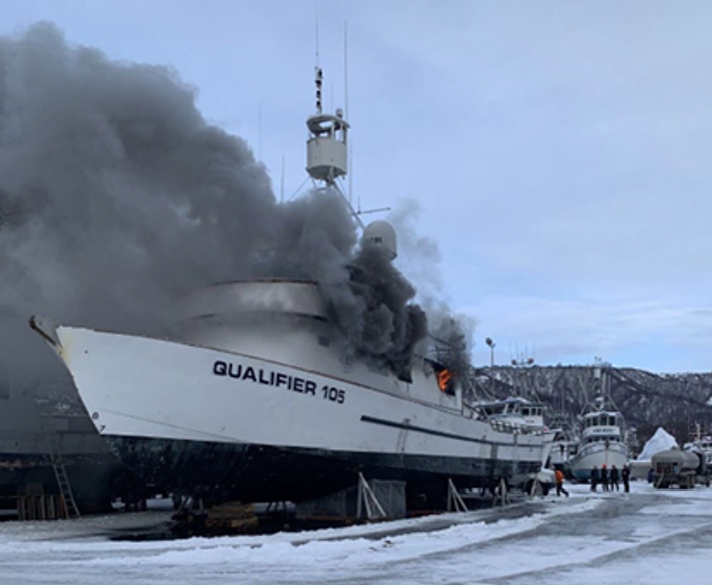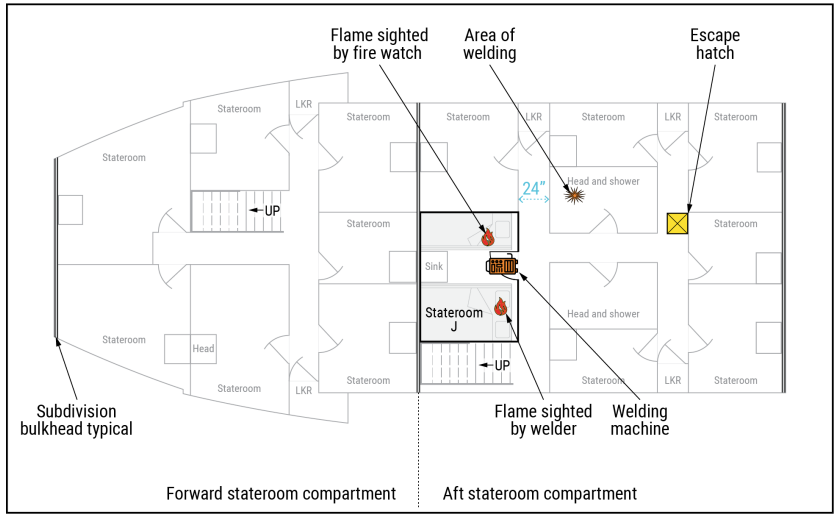NTSB: Fire on vessel – stray electrical current during welding
The National Transportation Safety Board of the United States (NTSB) has published report MIR-24-15 relating to a fire aboard a vessel which may have been caused by stray currents flowing during electrical welding work.

What happened
A fire started in a cabin below the main deck of the small passenger vessel Qualifier 105, which was being stored in a yard for the winter, on blocks. The local fire department responded and extinguished the fire. No pollution or injuries were reported. The vessel was effectively destroyed at a cost estimated to be $1.2 million.
At the time the fire started, welders were on board performing Aluminium hot work. While hot work can generate sparks and molten material that can ignite combustible materials, the two welders, who were working close to where the fire was discovered by the fire watch, did not find any signs of a fire during or after their work. Therefore, the hot work itself was not the source of the fire.
The fire watch and one welder each saw a small flame on two different bunks in a cabin. Those small flames were likely caused by ignition of combustible materials—including carpet, wood framing, and plastic sheeting—in the ceiling of the cabin and in the overhead bulkheads. This is dealt with in some detail in the report linked above.

Stray welding current—a fault condition where current goes through unintended conductors, such as metal framing or wires, and back to the return terminal of a welding machine—can result in heating and cause fires. On board the Qualifier 105, the welding machine work clamp (the return current clamp) was connected to an aluminium cross member below the deck in this cabin, about 3m from the point of welding. The return current had to travel through the vessel’s aluminium structure and/or conducting wires from the spool gun’s electrode back to the work clamp. The aluminium structure would have served as a conductor, and the resulting current in the structure may have found its way into the vessel’s electrical system. An electrical wire in the overhead of the cabin could have served as an unintended conductor and become overheated and eventually led to a fire.
However, investigators could not definitively determine that stray welding current caused wires to overheat. Additionally, there were several wires and electrical boxes in the cabin that may have been energized and become a potential electrical ignition source due to a fault. Therefore, the exact ignition source could not be determined.
What was the (probable) cause
The NTSB determined that the probable cause of the fire was an undetermined electrical source that ignited a stateroom ceiling. Contributing to the extent of the fire damage was the substantial use of combustible materials composing the stateroom ceilings and bulkheads throughout the vessel’s accommodation spaces.
Lessons Learned
- Take precautions against stray welding current: Stray welding current is a fault condition in which current goes through unintended conductors and back to the return terminal of a welding machine; it can cause fires by overheating wires. To avoid potential fires caused from stray welding current, maintenance personnel, owners, and operators should follow industry practice to place the work clamp (the return current clamp) of the welding machine as close as possible to the point of welding.
Members may wish to refer to:
Safety Event
Published: 3 September 2024
Download: IMCA SF 18/24
IMCA Safety Flashes
Submit a Report
IMCA Safety Flashes summarise key safety matters and incidents, allowing lessons to be more easily learnt for the benefit of all. The effectiveness of the IMCA Safety Flash system depends on Members sharing information and so avoiding repeat incidents. Please consider adding [email protected] to your internal distribution list for safety alerts or manually submitting information on incidents you consider may be relevant. All information is anonymised or sanitised, as appropriate.
IMCA’s store terms and conditions (https://www.imca-int.com/legal-notices/terms/) apply to all downloads from IMCA’s website, including this document.
IMCA makes every effort to ensure the accuracy and reliability of the data contained in the documents it publishes, but IMCA shall not be liable for any guidance and/or recommendation and/or statement herein contained. The information contained in this document does not fulfil or replace any individual’s or Member's legal, regulatory or other duties or obligations in respect of their operations. Individuals and Members remain solely responsible for the safe, lawful and proper conduct of their operations.
